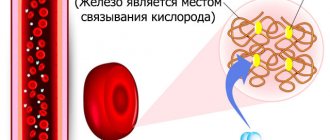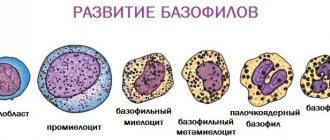Hemoglobin in men and women is a complex protein molecule that consists of a globule and four hemes. It is located on the biconcave surface of erythrocytes - red blood cells. Hemoglobin, due to the under-oxidized iron it contains, is involved in the transport of oxygen and carbon dioxide, thereby ensuring cellular respiration. The function of hemoglobin is also to maintain normal osmotic pressure in the blood. It is hemoglobin molecules that give the blood a bright red color, which is why arterial blood saturated with oxyhemoglobin is scarlet, and venous blood is dark burgundy.
What should a man's hemoglobin be, depending on age?
The hemoglobin content in the blood of males is slightly higher than that of females. Historically, men were more likely to do hard work that required good physical strength. Testosterone is a male sex hormone that promotes the rapid growth of muscle mass, which requires oxygen for normal functioning. Accordingly, the amount of hemoglobin increased to carry oxygen to the muscles in the required quantity.
However, it is now not uncommon to find a woman involved in weightlifting or working in exhausting work. It should be noted that in such representatives of the fairer sex, the amount of hemoglobin can be estimated according to male standards, and may even be higher than in men engaged in office work with a minimum amount of physical activity.
| Man's age | Normal hemoglobin content in blood |
| Newborn | 135-200 g/l |
| 1 month | 115-180 g/l |
| 2 months | 90-130 g/l |
| 6 months | 95-140 g/l |
| 1 year | 105-140 g/l |
| 5 years | 100-140 g/l |
| 12 years | 115-144 g/l |
| 15 years | 120-152 g/l |
| Under 18 years old | 117-160 g/l |
| After 18 to 40 years | 135-175 g/l |
| After 40 to 70 years | 132-173 g/l |
| Over 70 years old | 127-175 g/l |
The hemoglobin given above and its norm for men by age in the table are generalized values for the general mass of healthy people leading an average lifestyle. The peak of indicators occurs at the age of 30, and after fifty (50 years) a man’s activity decreases and the saturation of the body with hemoglobin also decreases. By the age of 20 and up to 60 years, the activity and functional capacity of red blood cells is the highest. And after 60 years, in untrained men, hemoglobin decreases slightly. For patients with any chronic diseases, working in difficult, dangerous or harmful jobs, the normal amount of hemoglobin should be calculated individually.
How to get tested
You can find out the amount of hemoglobin in the blood by taking a blood test in the laboratory. To obtain an accurate result, three days before the test, you should not drink alcohol or energy drinks, eat fatty and salty foods, drink large amounts of coffee and chocolate, or take medications (except for those that are taken regularly). On the day of the test, you should not drink, eat or smoke until the blood is drawn.
However, you should still remember: despite the fact that we live in a world of high technology and most laboratory analyzes are done using specialized equipment, errors in the results still occur. Rarely, healthy people receive tests with poor results. If a person feels great, but the result shows deviations from the norm, perhaps he should simply retake the test. But if the test result still differs from normal, you must immediately consult a doctor to select treatment.
Normal by age
The hemoglobin indicator is a certain number, but not constant. The norm may depend on the country of residence, specific living conditions, the patient’s age, habits, nutrition, and physical activity.
The average standard for adults reaches 140–160 g/l. These boundaries remain in the range of 18-39 years, then red blood cells decrease and hemoglobin decreases. For men over 40 years of age, the typical indicator is 130–150 g/l. Approximate values can be seen below.
Hemoglobin content g/l
Daily fluctuations
As the table by age shows, the highest value is observed in newborns, which is the physiological norm. For men who have reached maturity, the indicator no longer has such large values and fluctuations.
Paying attention to the interpretation of the analysis, experts take into account a number of factors that can reduce or increase hemoglobin.
Even during the day there are slight fluctuations. They usually do not exceed 17%. At the same time, in the morning the level is lower, and in the evening it may increase slightly.
Normal after 30 years
Between 18 and 40 years the figure is 118-160 g/l. This is the period when the values are the most overestimated, not counting newborns. The bodies of men over 30 years of age are subject to physical activity, which causes an increase in the indicator. Even a level of 170 g/l under certain conditions will not be considered a pathology.
After 40 years
During this period, the standards do not change significantly. But often people experience a decrease in the indicator due to significant abuse of alcoholic beverages or a decrease in physical activity.
After 50 years
A man at this age begins to suffer from various diseases, which worsens his health. In addition, the functional task of the genital organs gradually fades away, which leads to a normal level of 130-150 g/l, provided that the person leads a healthy lifestyle.
At the age of 60
Hemoglobin directly depends on the number of red blood cells. During this period of life, their share in the total blood composition decreases, which provokes a decrease in the indicator. The normal level after 60 years is 120-145 g/l.
For men over 70
After 70 years, it is necessary to maintain an indicator within the range of 115–140 g/l. For those over 80, protein should not fall below 110-130 g/l.
Causes and symptoms of low hemoglobin levels in men
According to statistics, men suffer from low levels of hemoglobin in the blood much less often than women, but this still happens quite often. Hemoglobin levels in men may be associated with the following reasons:
- moving to a region with different climatic conditions;
- heavy blood loss (including when donating blood and its components);
- eating disorders, dieting, raw food diet and vegetarianism;
- consumption of alcoholic beverages;
- drinking energy drinks;
- smoking hookah and cigarettes in large quantities;
- drinking large amounts of coffee and coffee drinks, chocolate;
- taking blood clotting medications;
- taking diuretics and laxatives;
- taking medications for weight loss;
- poisoning with various substances;
- diseases of the digestive tract;
- disorders of the pancreas, thyroid gland, liver and spleen;
- systemic blood diseases;
- damage to the body by parasites;
- infectious diseases;
- serious injuries;
- benign and malignant neoplasms.
Reduced hemoglobin
Some of the most common causes of anemia are:
- blood loss (traumatic injury, surgery, bleeding, colon cancer or stomach ulcer);
- nutritional deficiencies (iron, vitamin B12, folic acid);
- bone marrow problems (bone marrow replacement for cancer);
- suppression of red blood cell synthesis by chemicals;
- renal failure;
- abnormal hemoglobin structure (sickle cell anemia or thalassemia).
Lack of iron in the blood is an important sign of pathology. Often, low levels of iron-containing protein occur due to depletion of the body.
Symptoms of low hemoglobin levels
The main reasons for the development of iron deficiency anemia include the following:
- formation of tumor neoplasms;
- diseases caused by parasites;
- dysfunction of the thyroid gland;
- pathologies of the digestive tract;
- heavy blood loss (bleeding, donation);
- systemic blood diseases;
- strict diets, drying, vegetarianism;
- excessive consumption of chocolate and caffeinated drinks;
- alcohol intoxication.
Low hemoglobin in men is less common than in women. A lack of iron-containing protein in the body, which is responsible for transporting oxygen, is accompanied by general malaise. The patient is worried about weakness, headaches, and increased heart rate. A man's skin turns pale and his performance decreases.
How to increase hemoglobin?
If the amount of iron in the blood is low, you should also undergo an examination to help determine the cause of anemia. Most often, this condition can be managed with a diet that includes more foods that contain a lot of iron and other essential minerals. Usually it is advised to eat more meat, cereals, legumes, and nuts.
If the iron deficiency is too great, it will be extremely difficult to cope with it with diet alone. In this case, you need to take special anti-anemia medications that contain iron. In addition, vitamins B and C are usually prescribed. Vitamin C is necessary for these drugs to be absorbed better; it improves blood quality. At the same time, during treatment it is advised to avoid dairy products, since they, on the contrary, contribute to insufficient absorption of necessary substances.
In addition, it is usually advised to adopt a healthy lifestyle in general. If you have anemia, it is recommended to spend more time in the fresh air and choose the appropriate type of physical activity. Lack of physical exercise negatively affects the functioning of the heart and blood vessels, and the body as a whole.
You should not treat anemia or increased hemoglobin on your own; this can lead to serious consequences. It is imperative to identify the cause of this condition before starting treatment, otherwise it can cause harm and cause a deterioration in well-being.
Why is a low hemoglobin level dangerous?
In the human body, everything is very interconnected, and the connecting link is blood. Therefore, any deviation from the hemoglobin norm in men immediately affects the functioning of all organ systems. With a lack of hemoglobin in the blood, oxygen saturation of tissues deteriorates, and the nervous system suffers the most from this. The brain begins to work worse: a person perceives information poorly, quickly forgets everything and cannot concentrate. Plus, headaches and dizziness occur. With a long-term and severe lack of hemoglobin, everything can even end with irreversible changes in the brain. The heart, the main pump of the body, also suffers from lack of nutrition. The valve apparatus begins to work worse, the walls of the heart sac and blood vessels become thinner, which can lead to very serious consequences.
Anemia is like a time bomb - slowly but surely it eats the human body from the inside. All people, especially those over 45 years of age, need to undergo a general blood test at least once a year to monitor their health status in order to begin treatment on time and prevent serious consequences such as bleeding.
Decreased iron protein in the blood
The patient is prescribed a therapeutic diet, limiting the intake of an element such as iron. You will have to give up animal meat, legumes, sugar, smoked products, cream, as well as fatty, fried and high-bad cholesterol foods. You need to drink more water and lose those extra pounds. Physical activity should not be excessive. Viscous blood increases the risk of blood clots, which is extremely dangerous.
Both increased and decreased levels of iron-containing protein can be dangerous for the body’s functioning. But still, there is no need to draw premature conclusions, no matter what the hemoglobin level in the blood is. The table by age gives an idea of the range of fluctuations of this indicator, but only a doctor can draw conclusions about the state of health. A change in the level of this protein may cause a malfunction in the body. It is necessary to keep this under control and regularly do blood tests.
How to increase hemoglobin levels in the blood
When diagnosing a decrease, it is important to know the hemoglobin norms in men and find the cause of this indicator. If the reason is moving to another city, stress or fatigue, then you just need to rest, drink something strengthening, for example, a decoction of rose hips or hibiscus, and wait until the hemoglobin returns to normal. If the reason for a poor test result lies in the body’s lack of microelements, then it is necessary to determine what exactly is missing.
- For iron deficiency anemia, it is necessary to include liver, spleen, white fish, pomegranate, buckwheat and green apples in the diet. If a diet for low hemoglobin does not help, then you need to take iron supplements as prescribed by your doctor.
- If there is a lack of folic acid, you need to include green onions, parsley, celery, and white cabbage in your diet. If this does not help, then you need to take folic acid tablets as prescribed by your doctor.
- For B-12 deficiency anemia, you need to include eggs and lean beef in your diet. Butter and sour cream.
- With B-6 deficiency anemia, you should try to consume more dairy products, whole grain bread and legumes.
- If you are deficient in selenium, you should include bran, sunflower and sesame seeds, and hard cheese in your diet.
Consequences
For men, low hemoglobin is associated with a risk of serious consequences. Among them it is worth highlighting:
- Impaired functioning of the human immune system. Chronic anemia makes you more likely to contract various viruses and infections.
- Decreased performance and disruption of a healthy lifestyle due to constant fatigue and high fatigue.
- Decreased concentration and, as a result, a greater likelihood of accidents, for example, when driving a vehicle.
- Cardiomyopathy and heart failure, the development of which occurs due to insufficient oxygen supply, which causes a greater load on the heart.
- Increased liver size, swelling in the extremities.
- A negative effect on the nervous system, as a result of which psychomotor skills are disrupted and psycho-emotional imbalances occur.
Causes and symptoms of increased hemoglobin in men
A slight increase in hemoglobin may be normal in case of high physical activity, air travel or sports, if the person feels normal. Pathological causes of increased hemoglobin may be:
- head, liver and spleen injuries;
- diabetes mellitus of both types;
- severe dehydration of the body;
- damage to the skin;
- oncological diseases;
- increased iron content in the blood;
- increased content of B vitamins;
- intoxication of the body;
- diseases of the digestive system.
High hemoglobin in men's blood is much worse tolerated than low hemoglobin. A person develops a constant metallic taste in the mouth if hemoglobin is above 156, lack of appetite, or, on the contrary, insatiation. There is a strong unquenchable thirst, irritation of the mucous membranes. Body temperature often rises, the peculiarity is that it does not decrease in the usual ways. A person experiences a severe bursting headache, dizziness and even fainting. Patients become very irritable, or, on the contrary, indifferent to everything that happens.
If these or similar signs are detected, a person must definitely take a blood test to exclude or confirm the disease and begin its treatment in a timely manner.
How does increased hemoglobin manifest?↑
- Excessively red skin areas alternate with pathologically pale and flaky skin.
- Visual and hearing acuity decreases.
- Appetite is noticeably reduced.
- The man suffers from intestinal disorders, with diarrhea giving way to constipation.
- Increased fatigue and weakness.
- Dizziness.
- Headache.
- Pain in the joints and musculoskeletal system.
- Bursting pain in the abdominal area.
- Sleep disorders, insomnia.
- Increased risk of blood clots.
Why is an elevated hemoglobin level dangerous?
Any deviation of the blood composition from the norm affects the condition of the human body. The danger of an increased level of hemoglobin in the blood is that the blood changes its consistency. It becomes thicker and more viscous, therefore, despite the increased content of hemoglobin and oxygen, all organs experience oxygen starvation, which leads to various negative consequences.
In addition, thick blood causes blockage of blood vessels, the formation of blood clots and cholesterol plaques, which, in turn, can lead to damage or even rupture of the vessel. If it is a large vessel, it can lead to a cessation of nutrition to some organ and have critical consequences. It also has a bad effect on the functioning of the urinary system; salt deposits begin in the kidneys and bladder, which can subsequently turn into stones and prevent the organs from working.
In no case should you ignore increased hemoglobin! If left untreated for a long time, it can lead to many irreversible consequences: heart attacks and strokes, heart attacks, limb amputations, thrombosis and other dangerous diseases.
General information about hemoglobin
Hemoglobin is an iron-containing protein found in the blood. Its main function is the delivery of oxygen to tissue cells. In addition, it serves as the basis of red blood cells - erythrocytes.
This is interesting! The intensity of the color of the blood depends on the level of this protein. The more hemoglobin, the richer the red hue.
Hemoglobin is responsible for the delivery of oxygen to tissue cells
Since iron is the main component of hemoglobin, any pathological deviation from the norm negatively affects the body’s nutritional processes at the cellular level. A deficiency of oxygen and nutrients leads to various disorders.
This is interesting! Hemoglobin became the material on which the molecular origin of hereditary diseases was first shown.
How to lower hemoglobin levels in the blood
An increase in hemoglobin caused by an excess of iron and B vitamins can be cured at home. First, you need to determine which substances are in excess in the body and how many of them there are. For this purpose, a detailed biochemical blood test is prescribed. And then, depending on the hemoglobin level in men, a diet or therapeutic fasting is prescribed. In the first case, the consumption of legumes, green vegetables, red meat, fish, fatty dairy products, eggs and fruits is limited. The diet is dominated by cereals and protein-rich foods. A person must consume at least three liters of water per day, as well as move actively and often be in the fresh air.
If the excess of substances is very high, therapeutic fasting is prescribed according to the “every other day” scheme. One day you can only drink water or tea, the next you can eat according to your diet. And then fasting again until the indicators return to normal. Additionally, various diuretics and choleretic drugs are prescribed, and folk remedies are also used: currant juice, rosehip decoction, kidney tea.
When to worry
In an adult male, a deviation from the norm is considered to be an increase or decrease in hemoglobin by 20 g/l from the borderline values. If this happens, you should consult a doctor immediately. A sharp jump in the indicator may indicate the development of a serious illness.
A rapid increase is usually associated with infectious pathologies, stress, the development of heart failure, diabetes mellitus, Vaquez disease, erythrocytosis, and intestinal obstruction.
A rapid decrease in the indicator, especially if it drops below 90 g/l, indicates that anemia is developing. Moreover, at the first stage it will reach 90, at stage 2 - 70-85 g/l, at the third stage it may fall below 70 g/l, when urgent hospitalization is recommended. This is dangerous because severe oxygen starvation occurs and the heart muscle and brain are damaged .
How to normalize hemoglobin levels using folk remedies
For many centuries, our ancestors were treated without having any medicines or medical devices in their arsenal. Now the methods, selected experimentally, have found a scientific explanation and help people bring their health back to normal. Without resorting to artificially synthesized drugs.
A proper lifestyle, daily sleep and walks in the fresh air - something that seems insignificant to many, can significantly improve the condition of the blood. It must be remembered that in order to fully restore the body’s strength during sleep, it is necessary to sleep in a room with well-ventilated, not stagnant air. It’s even better with an open window or vent, if the time of year allows it. This will help the body be maximally saturated with oxygen and improve the nutrition of tissues and organs. When sleeping, the room should be as dark as possible. It is impossible to fully rest in the light, because melatonin, the hormone responsible for restoring the body’s strength, is produced only in the dark. If a person needs to sleep during the day (for example, working night shifts), then it is necessary to have thick curtains in dark colors, and do not forget to cover the windows with them. As a last resort, you can use special sleep glasses.
Breathing exercises have a very beneficial effect on the condition of the blood. You need to make it a habit every morning and every evening to take several deep breaths and slow exhalations, hold your breath for 30 seconds or more, and perform many frequent shallow breathing acts. These simple exercises will quickly help normalize your health.
Physical activity is very important for a man’s hemoglobin levels to be within normal limits. You don’t have to go to the gym, you can just walk up to the sixth floor, walk instead of drive to work, and do a few squats in between. Or you can just turn on your favorite music and have a mini-disco. So simple, and so effective.
The role of hemoglobin in the lives of men and the importance of maintaining the norm
Hemoglobin is a means of transporting oxygen molecules from the lungs to all tissues and organs. Iron protein helps control blood pH. It contains iron, which, when oxidized, can accept or release carbon dioxide and oxygen.
Hemoglobin levels in men are slightly higher than in women. This is explained by the fact that for the active growth of muscle mass, testosterone is required, which requires a larger volume of oxygen; accordingly, the number of blood cells must be significantly higher.
If the hemoglobin level increases or decreases significantly, many organs and systems of the body suffer. Their functionality is impaired, immunity decreases, and skin quality deteriorates. This is why it is important to maintain normal levels.
What is hemoglobin
Hemoglobin is a protein found in red blood cells. This element acts as a connecting link in metabolism, as it transports oxygen to all internal structures of the body and removes carbon dioxide from them. In addition to helping tissues “breathe,” the protein performs a pigment function, in other words, it gives the blood fluid a red tint.
Fluctuations in the required level of hemoglobin in the blood may indicate a pathological or some kind of stressful condition.
If any changes in the amount of hemoglobin are detected, patients are sent for additional studies, which help to reconstruct a complete clinical picture, and also allow one to diagnose/refute the presence of possible diseases.











